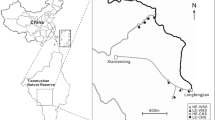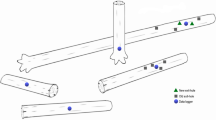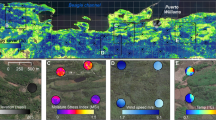Abstract
Microclimate is a crucial driver of saproxylic beetle assemblages, with more species often found in sunny forests than in shady ones. Whether this pattern is caused by a higher detectability due to increased beetle activity under sunny conditions or a greater diversity of beetles emerging from sun-exposed deadwood remains unclear. This study examined whether sun exposure leads to higher microclimatic heterogeneity in deadwood and whether this drives beetle diversity in deadwood logs and at forest stand scale. Saproxylic beetles were sampled at the stand scale using flight-interception traps and at object scale using stem-emergence traps on deadwood logs at the same site. The variability in wood surface temperature was measured on single logs and between logs as a proxy for microclimatic heterogeneity in deadwood. Abundance in sunny forests was higher at the stand scale, and in shady forests at the object scale. The estimated number of species was higher in sunny forests at both scales and correlated positively with temperature variability on single logs and between logs at the stand scale and, albeit weakly, with temperature variability on single logs at the object scale. Gamma-diversity, and thus beta-diversity, across logs at the object scale was higher in sunny forests. These findings indicate that sun exposure promotes saproxylic beetle diversity due to higher microclimatic heterogeneity within and between deadwood logs. Our study therefore corroborates previous research demonstrating the importance of canopy cover and microclimate for forest biodiversity.




Similar content being viewed by others
References
Alroy J (2010) Geographical, environmental and intrinsic biotic controls on Phanerozoic marine diversification. Palaeontology 53:1211–1235. https://doi.org/10.1111/j.1475-4983.2010.01011.x
Bates D, Mächler M, Bolker B, Walker S (2015) Fitting linear mixed-effects models using lme4. J Stat Softw. https://doi.org/10.18637/jss.v067.i01
Birkemoe T, Sverdrup-Thygeson A (2015) Trophic levels and habitat specialization of beetles caught on experimentally added aspen wood: does trap type really matter? J Insect Conserv 19:163–173. https://doi.org/10.1007/s10841-015-9757-6
Bouget C, Duelli P (2004) The effects of windthrow on forest insect communities: a literature review. Biol Conserv 118:281–299. https://doi.org/10.1016/j.biocon.2003.09.009
Bouget C, Brin A, Brustel H (2011) Exploring the “last biotic frontier”: are temperate forest canopies special for saproxylic beetles? For Ecol Manag 261:211–220. https://doi.org/10.1016/j.foreco.2010.10.007
Bouget C, Larrieu L, Nusillard B, Parmain G (2013) In search of the best local habitat drivers for saproxylic beetle diversity in temperate deciduous forests. Biodivers Conserv 22:2111–2130. https://doi.org/10.1007/s10531-013-0531-3
Brackebusch AP (1975) Gain and loss of moisture in large forest fuels. USDA Forest Service, Research Paper INT-173
Chao A, Jost L (2012) Coverage-based rarefaction and extrapolation: standardizing samples by completeness rather than size. Ecology 93:2533–2547. https://doi.org/10.1890/11-1952.1
Chao A, Gotelli NJ, Hsieh TC et al (2014) Rarefaction and extrapolation with Hill numbers: a framework for sampling and estimation in species diversity studies. Ecol Monogr 84:45–67. https://doi.org/10.1890/13-0133.1
Clarke A, Gaston KJ (2006) Climate, energy and diversity. Proc R Soc B Biol Sci 273:2257–2266. https://doi.org/10.1098/rspb.2006.3545
De Frenne P, Zellweger F, Rodríguez-Sánchez F et al (2019) Global buffering of temperatures under forest canopies. Nat Ecol Evol 3:744–749. https://doi.org/10.1038/s41559-019-0842-1
De Frenne P, Lenoir J, Luoto M et al (2021) Forest microclimates and climate change: importance, drivers and future research agenda. Glob Change Biol 27:2279–2297. https://doi.org/10.1111/gcb.15569
Elston DA, Moss R, Boulinier T et al (2001) Analysis of aggregation, a worked example: numbers of ticks on red grouse chicks. Parasitology 122:563–569. https://doi.org/10.1017/S0031182001007740
Gossner MM, Wende B, Levick S et al (2016) Deadwood enrichment in European forests—which tree species should be used to promote saproxylic beetle diversity? Biol Conserv 201:92–102. https://doi.org/10.1016/j.biocon.2016.06.032
Grove SJ (2002) Saproxylic insect ecology and the sustainable management of forests. Annu Rev Ecol Syst 33:1–23
Haddad NM, Tilman D, Haarstad J et al (2001) Contrasting effects of plant richness and composition on insect communities: a field experiment. Am Nat 158:17–35. https://doi.org/10.1086/320866
Hagge J, Leibl F, Müller J et al (2019) Reconciling pest control, nature conservation, and recreation in coniferous forests. Conserv Lett 12:e12615. https://doi.org/10.1111/conl.12615
Heidrich L, Bae S, Levick S et al (2020) Heterogeneity–diversity relationships differ between and within trophic levels in temperate forests. Nat Ecol Evol 4:1204–1212. https://doi.org/10.1038/s41559-020-1245-z
Jost L (2010) The relation between evenness and diversity. Diversity 2:207–232. https://doi.org/10.3390/d2020207
Krah FS, Seibold S, Brandl R et al (2018) Independent effects of host and environment on the diversity of wood-inhabiting fungi. J Ecol 106:1428–1442. https://doi.org/10.1111/1365-2745.12939
Leutner B (2018) Space for communities: quantifying data requirements for remote sensing based habitat modeling. Julius-Maximilians-Universität Würzburg
Liu S-S, Zhang G-M, Zhu J (1995) Influence of temperature variations on rate of development in insects: analysis of case studies from entomological literature. Ann Entomol Soc Am 88:107–119. https://doi.org/10.1093/aesa/88.2.107
Möller G (2009) Struktur- und Substratbindung holzbewohnender Insekten, Schwerpunkt Coleoptera—Käfer. Dissertation at Freien Universität Berlin. Freie Universität Berlin
Müller J, Brustel H, Brin A et al (2015) Increasing temperature may compensate for lower amounts of dead wood in driving richness of saproxylic beetles. Ecography (cop) 38:499–509. https://doi.org/10.1111/ecog.00908
Müller J, Ulyshen M, Seibold S et al (2020) Primary determinants of communities in deadwood vary among taxa but are regionally consistent. Oikos 129:1579–1588. https://doi.org/10.1111/oik.07335
Oksanen AJ, Blanchet FG, Friendly M, et al (2020) The vegan package. Community ecology package. http://cran.r-project.org/
Penone C, Allan E, Soliveres S et al (2019) Specialisation and diversity of multiple trophic groups are promoted by different forest features. Ecol Lett 22:170–180. https://doi.org/10.1111/ele.13182
Pouska V, Macek P, Zíbarová L (2016) The relation of fungal communities to wood microclimate in a mountain spruce forest. Fungal Ecol 21:1–9. https://doi.org/10.1016/j.funeco.2016.01.006
Schmidl J, Bussler H (2004) Ökologische Gilden xylobionter Käfer Deutschlands. Naturschutz Und Landschaftsplanung 36:202–218
Seibold S, Bässler C, Brandl R et al (2015) Experimental studies of dead-wood biodiversity—a review identifying global gaps in knowledge. Biol Conserv 191:139–149. https://doi.org/10.1016/j.biocon.2015.06.006
Seibold S, Bässler C, Brandl R et al (2016) Microclimate and habitat heterogeneity as the major drivers of beetle diversity in dead wood. J Appl Ecol 53:934–943. https://doi.org/10.1111/1365-2664.12607
Seibold S, Hagge J, Müller J et al (2018) Experiments with dead wood reveal the importance of dead branches in the canopy for saproxylic beetle conservation. For Ecol Manag 409:564–570. https://doi.org/10.1016/j.foreco.2017.11.052
Seibold S, Rammer W, Hothorn T et al (2021) The contribution of insects to global forest deadwood decomposition. Nature 597:77–81. https://doi.org/10.1038/s41586-021-03740-8
Seidl R, Thom D, Kautz M et al (2017) Forest disturbances under climate change. Nat Clim Change 7:395–402. https://doi.org/10.1038/nclimate3303
Senf C, Pflugmacher D, Zhiqiang Y et al (2018) Canopy mortality has doubled in Europe’s temperate forests over the last three decades. Nat Commun 9:4978. https://doi.org/10.1038/s41467-018-07539-6
Stokland JN, Siitonen J, Jonsson BG (2012) Biodiversity in dead wood. Cambridge University Press, Cambridge
Sverdrup-Thygeson A, Birkemoe T (2009) What window traps can tell us: effect of placement, forest openness and beetle reproduction in retention trees. J Insect Conserv 13:183–191. https://doi.org/10.1007/s10841-008-9141-x
Taylor LR (1963) Analysis of the effect of temperature on insects in flight. J Anim Ecol 32:99. https://doi.org/10.2307/2520
Thom D, Sommerfeld A, Sebald J et al (2020) Effects of disturbance patterns and deadwood on the microclimate in European beech forests. Agric for Meteorol 291:108066. https://doi.org/10.1016/j.agrformet.2020.108066
Ulyshen MD (ed) (2018) Saproxylic insects: diversity, ecology and conservation. Springer International Publishing, Cham
Vodka S, Konvicka M, Cizek L (2008) Habitat preferences of oak-feeding xylophagous beetles in a temperate woodland: implications for forest history and management. J Insect Conserv 13:553–562. https://doi.org/10.1007/s10841-008-9202-1
Vogel S, Bussler H, Finnberg S et al (2020a) Diversity and conservation of saproxylic beetles in 42 European tree species: an experimental approach using early successional stages of branches. Insect Conserv Divers. https://doi.org/10.1111/icad.12442
Vogel S, Gossner MM, Mergner U et al (2020b) Optimizing enrichment of deadwood for biodiversity by varying sun exposure and tree species: an experimental approach. J Appl Ecol. https://doi.org/10.1111/1365-2664.13648
Zellweger F, De Frenne P, Lenoir J et al (2020) Forest microclimate dynamics drive plant responses to warming. Science 368:772–775. https://doi.org/10.1126/science.aba6880
Acknowledgements
We thank the administration of the Bavarian Forest National Park. Special thanks to Willi Hoff for supporting this project for several years. We also thank Boris Büche and Alexander Szallies for identifying beetles to the species level, and all helpers in the field and laboratory.
Funding
This research was supported by the project ‘BioHolz’ (Grant no. 01LC1323A) in the funding program “Research for the Implementation of the National Biodiversity Strategy (F&U NBS)” of the German Federal Ministry for Education and Research (BMBF) and the German Federal Agency for Nature Conservation (BfN), with funds provided by the German Federal Ministry for the Environment, Nature Conservation and Nuclear Safety (BMU).
Author information
Authors and Affiliations
Contributions
SS, JH, and LL developed the idea of the manuscript. RB, CB, and JM designed the experiment. LL, SS, and JH collected the data. LL and JH analyzed the data. LL, SS, and JH led the writing of the manuscript. All authors have contributed critically to the drafts and gave final approval for publication of the submitted manuscript.
Corresponding author
Ethics declarations
Conflict of interest
The authors have no conflicts of interest to declare.
Additional information
Communicated by Joel Trexler .
Supplementary Information
Below is the link to the electronic supplementary material.
Rights and permissions
About this article
Cite this article
Lettenmaier, L., Seibold, S., Bässler, C. et al. Beetle diversity is higher in sunny forests due to higher microclimatic heterogeneity in deadwood. Oecologia 198, 825–834 (2022). https://doi.org/10.1007/s00442-022-05141-8
Received:
Accepted:
Published:
Issue Date:
DOI: https://doi.org/10.1007/s00442-022-05141-8




